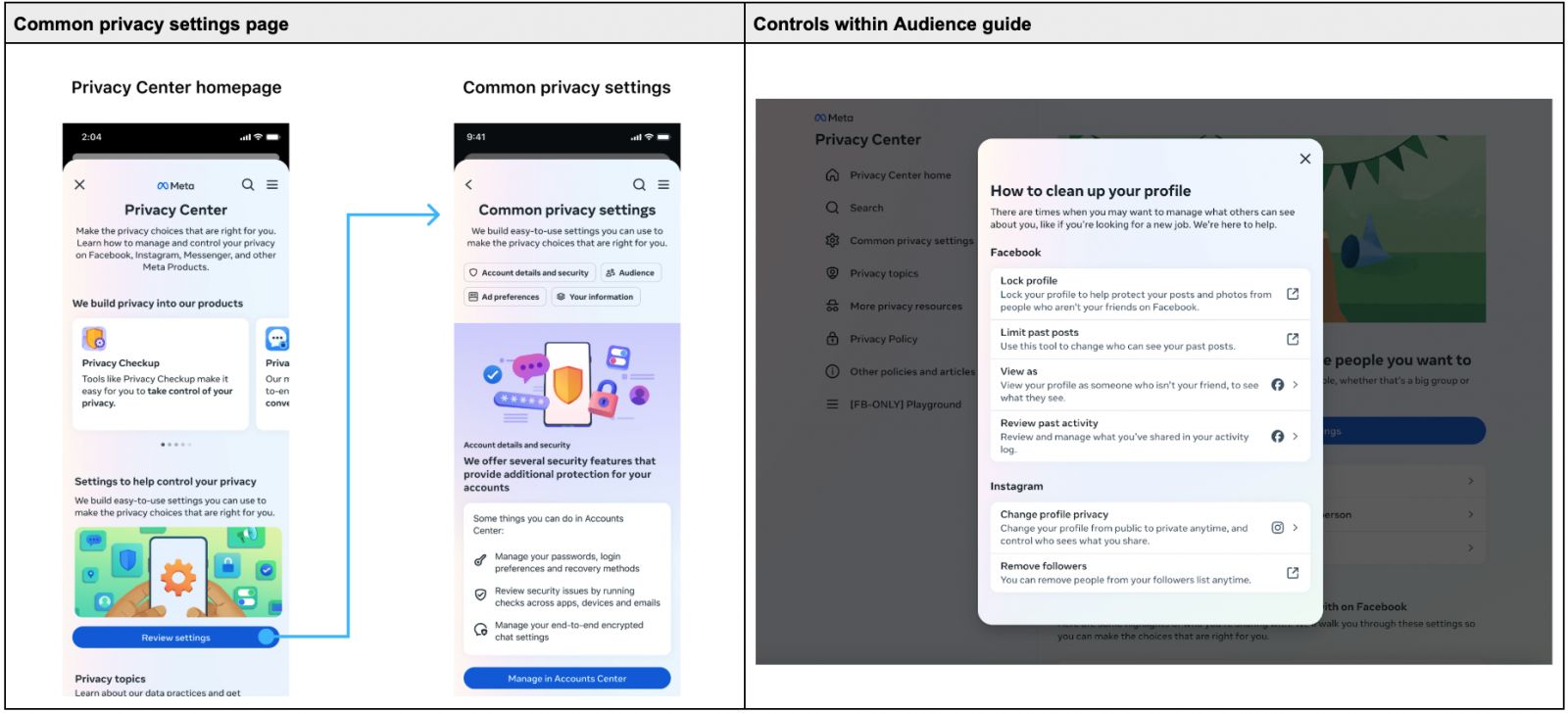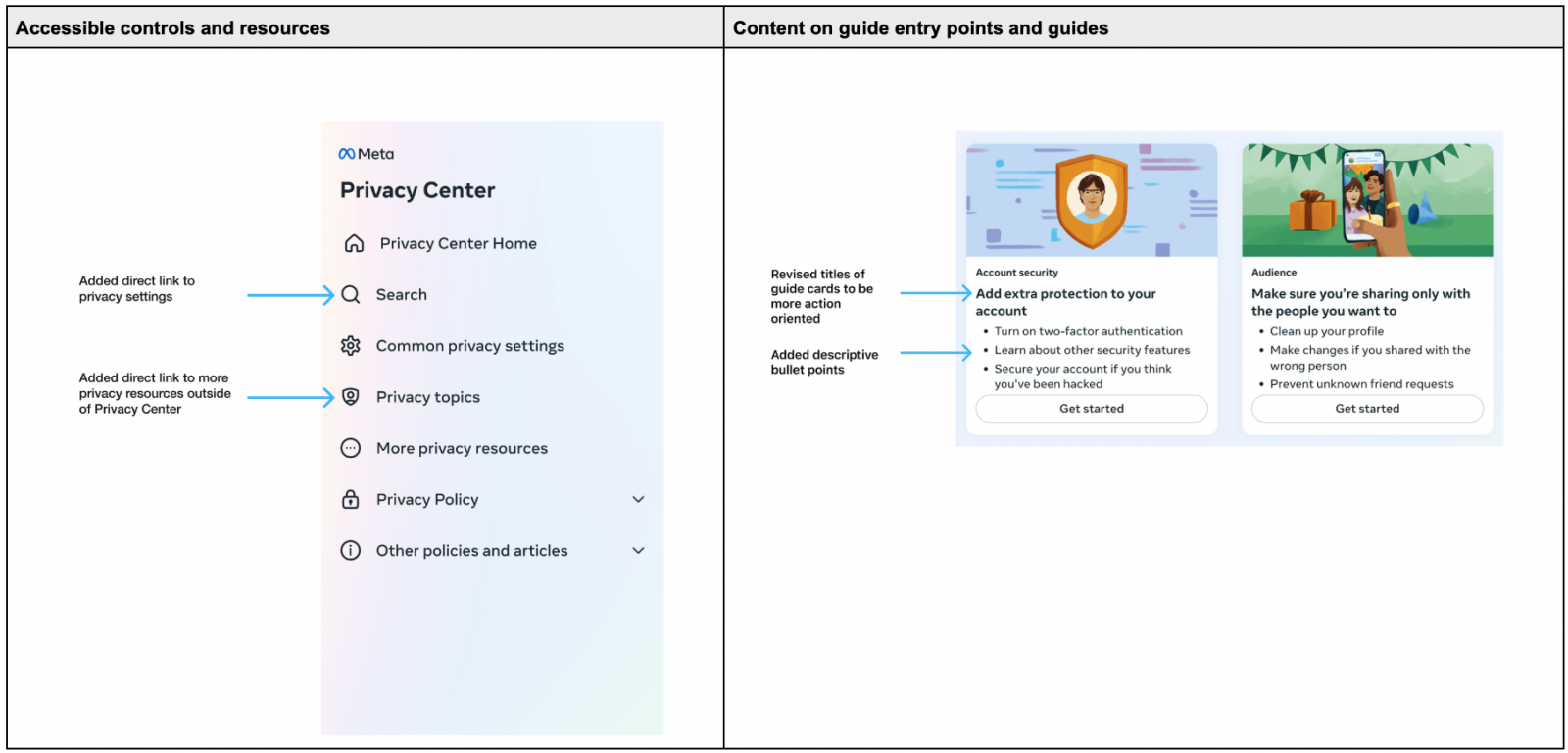Publication date: 9 May, 2025
Summary
Privacy education and transparency can empower users and support regulatory compliance.
Meta’s Privacy Center is the central hub for personalized privacy education, addressing user privacy concerns and providing access to privacy controls across Meta’s products.
The education in Privacy Center is primarily displayed using a “guide” format, which provides an overview of a privacy concept along with access to related controls available in Meta’s products.
This report summarizes research-informed considerations that have supported Meta’s approach to developing privacy guides and can assist others in creating effective privacy education materials.
Introduction: Privacy Education at Meta
At Meta, we recognize the importance of privacy education and transparency in helping users make informed decisions about their information. To support this, we have established Privacy Center as a centralized hub offering clear, practical guides on how Meta uses data and how users can manage their privacy settings.
We have continuously improved Privacy Center by utilizing a variety of approaches, including leveraging research to address the diverse needs of our users. Consequently, this summary of research insights is not an exhaustive list of principles we have applied; rather, it has been used in conjunction with other initiatives to improve Privacy Center.
The research insights have been distilled into five key design considerations, drawn from 8 qualitative studies involving 72 participants across 4 different countries - United States, India, Brazil and Germany. In the following section, we outline these considerations.
The 5 Key Considerations in Developing Privacy Education Materials
1: Align Information with User Needs & Concerns to Build Relevance
We’ve learned that it is essential to develop privacy education that is relevant by focusing on users’ specific concerns and needs. By understanding what matters most to users, we can develop content that resonates with them. For instance, a study showed that the Ads guide in Meta’s Privacy Center effectively answered users' questions about seeing similar ads online by explaining how Meta uses partner information for personalized ads. The focus on relevant topics, paired with clear explanations, helps users find value in the content because their specific concerns are effectively addressed.
Recommendation:
To make privacy education relevant to users, consider addressing common user questions directly with specific answers and clear explanations to help users feel their concerns are acknowledged and understood.
2: Inform Users About Controls to Build a Sense of Agency
Studies have shown that understanding how to leverage privacy controls when needed is a core aspect of effective privacy education. In a study of the “Sharing Off-Meta” Privacy Center guide, participants found it helpful when the guide explained how they could opt in or out of data sharing. These clear instructions directly addressed their concerns about agency over their data and gave them confidence in managing their privacy settings.
Recommendation:
To support users in understanding and using privacy controls, consider providing clear, actionable instructions on available controls, and ensure they are highlighted within education.
Examples

3: Simplify Navigation to Enhance Usability
Clear and intuitive navigation helps users find the information they need quickly and reduces cognitive load. In a study of the Ads guide, participants preferred fewer clicks to reach their destination and appreciated layouts that used clear headings and bullet points that helped break down dense topics into easily consumable, actionable pieces.
Recommendation:
Consider structuring guides with clear headings, concise sections, and tools like FAQs or bullet points to align with peoples’ preferences for quick and direct access to information. Reducing the number of steps or clicks required to reach key content can further enhance usability and ensure users can find what they need efficiently.
Examples

4: Diversify Education Formats to Engage Different Learning Preferences
Effective privacy education takes a diverse approach to formats, recognizing that users have varying preferences for how they consume information. In one study, some research participants preferred text-based guides, while others found videos and visuals more engaging. Multimedia formats, such as videos and interactive visuals were particularly considered engaging and easy to follow with complex or technical content.
Recommendation:
Consider incorporating a mix of text, visuals, and multimedia formats to address different user preferences. Multimedia formats could be particularly helpful in communicating technical privacy topics.

5: Integrate Privacy Education into User Journeys to Make it Accessible
Effective privacy education is integrated into user journeys, ensuring information is available when and where it is needed. In one study, participants valued having a centralized hub, like Meta’s Privacy Center, that addresses privacy concerns and provides access to resources. However, they also found it helpful when privacy education was embedded at different points in their journeys, such as during account onboarding or when managing account settings.
Recommendation:
Consider embedding privacy education into key moments of the user journey, such as onboarding, consent flows, or feature updates, to make it more accessible and relevant.
Conclusion
Meta’s approach to developing and refining privacy education materials demonstrates our commitment to transparency and user empowerment. By incorporating key considerations – such as aligning with user concerns, enabling a sense of agency, simplifying navigation, diversifying formats, and integrating into user journeys – Meta aims to continue to provide practical, accessible, and actionable privacy education materials that resonate with users.
In this article, we have shared insights and considerations informed by user research to help others develop effective privacy education materials, which have been instrumental in shaping our guides. As privacy expectations and digital landscapes evolve, continuously adapting and improving materials based on feedback remains essential for supporting informed decision-making, and evolving our strategies for privacy education.
Meta aims to keep pace with these developments, ensuring that our users are well-equipped to navigate their privacy with confidence. We encourage other organizations to adopt similar considerations in their privacy education to foster a more informed and empowered online community.



